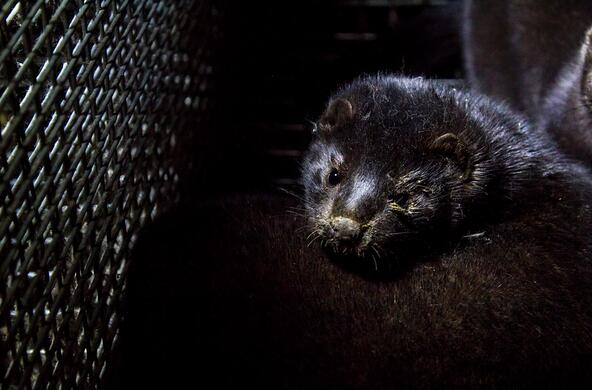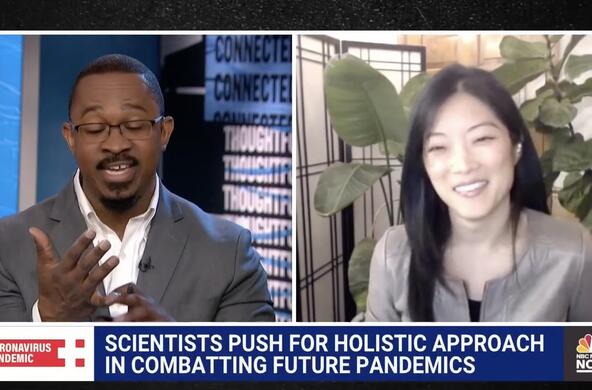In the summer of 2003, just weeks after an outbreak of monkeypox sickened about 70 people across the Midwest, Mark Slifka visited “the super-spreader,” he told me, “who infected half of Wisconsin’s cases.”
Chewy, a prairie dog, had by that point succumbed to the disease, which he’d almost certainly caught in an exotic-animal facility that he’d shared with infected pouched rats from Ghana. But his owners’ other prairie dog, Monkey—named for the way he clambered about his cage—had contracted the pathogen and survived. “I was a little worried,” said Slifka, an immunologist at Oregon Health & Science University. All the traits that made Monkey a charismatic pet also made him an infectious threat. He cuddled and nibbled his owners; when they left the house, he’d swaddle himself in their clothing until they returned. “It was sweet,” Slifka told me. “But I was like, ‘Can Monkey be in his cage when we come over?’”
Slifka made it home pox-free, and the 2003 outbreak fizzled out. But that rash of cases was a close call: an opportunity for the virus to set up shop in a new animal host. One lasting interspecies hop, akin to the one that SARS-CoV-2 has made into white-tailed deer, and monkeypox will be “with us forever” in the U.S., says Barbara Han, a disease ecologist at the Cary Institute, in New York. In Central and West Africa, where the virus is endemic, scientists suspect that at least a couple of rodent species intermittently slosh it into humans. And as the largest-ever epidemic of monkeypox outside of Africa in history continues to unfurl—more than 2,700 confirmed and suspected cases have been reported across roughly three dozen countries—the virus is now getting plenty more shots on goal. This time, we may not get so lucky; the geography of monkeypox might soon change.
Any new leaps could reshape the future for this virus, and for us. Experts consider the possibility unlikely—“low risk, but it is a risk,” says Jeffrey Doty, a disease ecologist at the CDC. Existing animal reservoirs make some diseases near impossible to snuff out; the emergence of new ones could seed future outbreaks in places where they’re not currently common. If researchers can ID some of those animals, and keep them from mingling with us, we could head off a few of those issues. But that’s a big if. With so many susceptible animals out there, figuring out which ones harbor the virus could send researchers on a yearslong race, without a clear finish line.
Scientists first discovered monkeypox in the 1950s, in two species of monkeys housed at a Danish animal facility; hence the name, which will likely change soon. But in the decades since, the best evidence of the virus lingering in animals has been tugged from rodents in Central and West Africa, including rope squirrels, sun squirrels, Gambian pouched rats, and dormice. All signs point to rodents being “responsible for maintaining this virus in the wild,” Doty told me, and so he and his colleagues worry most about those mammals when they ponder what animals in non-endemic regions may pose the most future risk.
Recommended Reading
But a lot of rodents scurry the planet—about 2,500 species, which together make up roughly 40 percent of known mammals. Though not all species are capable of carrying monkeypox—for example, guinea pigs, golden hamsters, and common mice and rats usually don’t—many of them can.
Building the case for an animal reservoir tends to require years of fieldwork, rigorous safety protocols, and a good deal of luck. For a few viruses, the reservoir narrative is relatively neat: Hendra virus, an often-fatal respiratory infection, typically moves from bats to horses to people; most hantaviruses, which can cause lethal fevers, set up shop in one rodent species each. Monkeypox, however, is far less picky than that. Experts suspect that multiple animals keep the virus percolating in the wild. Just how many, though, is anyone’s guess.
The gold standard for establishing a reservoir requires isolating active virus—proof that the pathogen was xeroxing itself inside of a viable host. But in the wilds of nature, “you can break your back and end up getting only five animals from a species,” Han, who’s been using machine learning to try to predict potential monkeypox reservoirs, told me. “And what’s five animals?” They may lack the virus in question, even if other members of their population harbor it; they may have been caught at an age, or during a season, when the pathogen’s not present. And among the animals that host the virus, a reservoir might not always be the most obvious species: Rodents might be among the most commonly detected carriers of monkeypox, but zoo outbreaks and laboratory experiments have shown the virus to be capable of infiltrating anteaters, rabbits, and a hefty handful of primates, along with other un-mousy mammals. In several of these species and others, scientists have found antibodies that recognize poxviruses, hinting at past exposures; they’ve even uncovered the virus’s DNA. Only twice, though, has anyone found active virus in wild animals: a rope squirrel from the Democratic Republic of Congo in the 1980s, and a sooty mangabey, found in Côte d’Ivoire about a decade ago.
Even those cases weren’t slam dunks. It takes more to “figure out which one is a reservoir, versus which ones get infected, but aren’t actually responsible for maintaining circulation of the virus” in nature, then spilling it into human communities, Jamie Lloyd-Smith, a disease ecologist at UCLA, told me. Just because an animal could bop the virus into us doesn’t mean that it will.
For that to happen, humans need to have enough contact with the animals to make exposure likely—on routine hunts for bushmeat, for instance, or in fractured landscapes where animals forage for food in and around people’s homes. Lloyd-Smith, who has been analyzing surveys of residents of the Congo, said parsing what’s risky and what’s not is tougher than it sounds: Most everyone in these areas interacts with forest creatures all the time. “It’s not like, ‘Oh, it was the people who ate the salmon mousse at the church breakfast,’” he told me. To complicate matters further, wild and domesticated animals can act as intermediaries between humans and a true reservoir, says Stephanie Seifert, a disease ecologist at Washington State University. Researchers sometimes have to traverse webs of interaction, moving through Kevin Bacon–esque degrees of separation, to pinpoint the original source.
Unveiling those natural origins is key to blocking the virus from moving onto new real estate—and, perhaps, breaking existing tenancies. In Central and West Africa, for instance, where some people’s livelihoods depend on hunting and eating wild game, “You can’t just say, ‘Don’t interact with rodents,’” Seifert told me. But with more investigation, says Clement Meseko, a veterinarian and virologist studying the human-wildlife interface at Nigeria’s National Veterinary Research Institute, perhaps experts could eventually pinpoint just a couple of species, then recommend sustainable alternatives in their place. Improved sanitation to keep rodent pests away from humans could also help. So could doling out vaccines to people who live in the high-risk regions of endemic countries—or perhaps to worrisome wild animals themselves. (Immunizing animals is a pretty lofty goal, but may still be a better alternative to culling animals, which “often doesn’t work,” Lloyd-Smith said.)
In the U.S., amid the current rash of monkeypox cases, the CDC has recommended that infected people avoid interacting with pets, livestock, and other animals altogether. Though no cat or dog has ever been known to contract the infection, “we basically know nothing about monkeypox in common companion animals,” Doty said. For now, it’s best to play it safe.
And the most meaningful way to keep the virus from surging into a new animal species, Han said, “is to control the human outbreak.” Already, monkeypox’s species range is formidable, and in today’s world, humans and animals are colliding more frequently. Amid the ongoing outbreak, Meseko, who is spending the year completing a fellowship in St. Paul, Minnesota, has been taking note of “how squirrels are just free all over the place.” Whatever threat they might pose to us, “animals are also in danger from humans,” he told me.
Human activity, after all, brought monkeypox to the U.S. in 2003, and into a coterie of prairie dogs that included Chewy and Monkey. “They would not have been exposed geographically without us moving around this virus,” Seifert said. And the human desire for pets brought those prairie dogs into dozens of midwestern homes. People mobilize disease; our species, too, poses an immense infectious threat to the planet. The current monkeypox outbreak, for instance, is more sprawling and human-centric than those documented in the past. And the more opportunity the virus has to infiltrate new hosts, the more opportunity it has to expand its species range. Any trickle into animals might not be detected until too late; perhaps, some experts pointed out, it already occurred long ago, seeding a reservoir that helped the ongoing epidemic erupt. “We have no evidence of that right now,” says Grant McFadden, a poxvirus expert at Arizona State University. “But that could change on a dime.”







